
Calluna vulgaris, common heather, ling, or simply heather, is the sole species in the genus Calluna in the flowering plant family Ericaceae. It is a low-growing evergreen shrub growing to 20 to 50 centimetres tall, or rarely to 1 metre (39 in) and taller, and is found widely in Europe and Asia Minor on acidic soils in open sunny situations and in moderate shade. It is the dominant plant in most heathland and moorland in Europe, and in some bog vegetation and acidic pine and oak woodland. It is tolerant of grazing and regenerates following occasional burning, and is often managed in nature reserves and grouse moors by sheep or cattle grazing, and also by light burning.

Argyreia nervosa is a perennial climbing vine native to the Indian subcontinent and introduced to numerous areas worldwide, including Hawaii, Africa, and the Caribbean. Though it can be invasive, it is often prized for its aesthetic and medicinal value. Common names include Hawaiian baby woodrose, adhoguda अधोगुडा or vidhara विधारा (Sanskrit), elephant creeper and woolly morning glory. Its seeds are known for their powerful entheogenic value, greater or similar to those of varieties from the Convolvulaceae family, with users reporting significant psychedelic and spiritual experiences. The two botanical varieties are A. n. var. nervosa described here, and A. n. var. speciosa, which are used in Ayurvedic medicine for their medicinal value.

The Chonos Archipelago is a series of low mountainous elongated islands with deep bays, traces of a submerged Chilean Coast Range. Most of the islands are forested with little or no human settlement. The deep Moraleda Channel separates the islands of the Chonos Archipelago from the mainland of Chile and from Magdalena Island.

Psychotria is a genus of flowering plants in the family Rubiaceae. It contains 1,582 species and is therefore one of the largest genera of flowering plants. The genus has a pantropical distribution and members of the genus are small understorey trees in tropical forests. Some species are endangered or facing extinction due to deforestation, especially species of central Africa and the Pacific.
The flora of the Chatham Islands consists of around 388 terrestrial plant species, of which 47 are endemic. The Chatham Islands make up the Chatham floristic province of the Neozeylandic Region of the Antarctic Kingdom.

Banksia alliacea is a species of shrub that is endemic to southwestern Western Australia. It grows to 2 m high and wide, with shaving brush-shaped inflorescences that smell of onions.
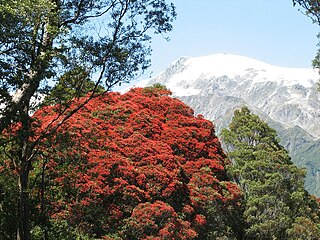
Metrosideros umbellata, the southern rata, is a tree endemic to New Zealand. It grows up to 15 metres (49 ft) or more tall with a trunk up to 1 metre or more in diameter. It produces masses of red flowers in summer. Unlike its relative, northern rata, this species rarely grows as an epiphyte.

Astelia waialealae is a rare species of plant in the Asteliaceae family that is endemic to the island of Kauaʻi of the state of Hawaii in United States. It inhabits montane bogs within the vicinity of the Alakaʻi Swamp on the island's central plateau. A. waialealae is threatened by habitat loss and habit disturbance by feral pigs; there are only about 26 plants remaining. It is a federally listed endangered species.

Astelia is a genus of flowering plants in the recently named family Asteliaceae. They are rhizomatous tufted perennials native to various islands in the Pacific, Indian, and South Atlantic Oceans, as well as to Australia and to the southernmost tip of South America. A significant number of the known species are endemic to New Zealand. The species generally grow in forests, swamps and amongst low alpine vegetation; occasionally they are epiphytic.

Elattostachys nervosa, known as the green tamarind or beetroot tree is a common rainforest tree of eastern Australia. Found in all types of rainforest, growing from Paterson, New South Wales in the south to Gympie in south east Queensland. The name Elattostachys refers to "little spikes", a flower feature of other plants in this genus. Nervosa refers to the prominent leaf venation. Beetroot Tree refers to the beetroot red leaves of the new growth.
Omiodes scotaea is a moth of the family Crambidae. It is endemic to the Hawaiian islands of Oahu, Molokai and Hawaii.

Astelia fragrans, commonly known as bush lily, bush flax or kakaha, is the most common astelia species found in New Zealand. It grows from sea level to elevations of approximately 900 metres.
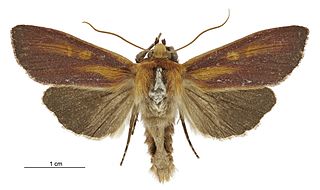
Ichneutica purdii, the orange astelia wainscot, is a moth of the family Noctuidae. It is endemic to New Zealand. It can be found throughout the main islands of New Zealand. I. purdii is a relatively large, colourful moth, unlikely to be confused with any other endemic moth species in New Zealand. The larvae of this moth feed at night on species of Astelia. During the day they shelter in the interior of the plant. When fully grown the larvae can reach a length of approximately 48mm. The larvae are ocherous in colour with a pink flush with line markings but when ready to pupate these markings fade and the larvae take on a light golden hue with a rosy tinge to its rear segments. The deep wine coloured pupa is enclosed in a slight cocoon, with this being constructed below the soil, amongst debris or alternatively within a hollow stick. The adult moths are on the wing from October to March. Although this moth is found throughout the main islands of New Zealand it is more frequent in the south of New Zealand at higher altitudes of up to 1200m.
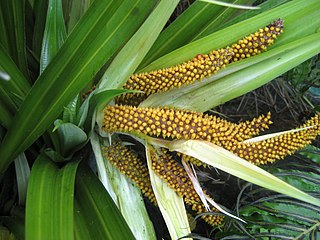
Collospermum is a genus of plants in the Asteliaceae all native to various islands in the Pacific Ocean, first described as a genus in 1934. It contains 5 currently recognized species. It is sometimes considered a synonym of Astelia.
- Collospermum hastatum(Colenso) Skottsb. -- New Zealand
- Collospermum microspermum(Colenso) Skottsb. -- New Zealand North Island
- Collospermum montanum(Seem.) Skottsb. -- Fiji + Vanuatu
- Collospermum samoenseSkottsb. - Samoa
- Collospermum spicatum(Colenso) Skottsb. - New Zealand North Island
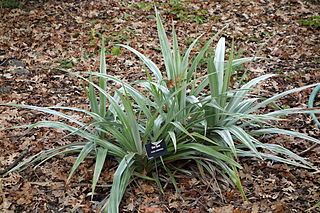
Astelia chathamica, the Chatham Islands kakaha, Maori flax, or silver spear, is a species of flowering plant in the recently named family Asteliaceae. It is an evergreen silver-green perennial from the Chatham Islands of New Zealand, growing to about 1.2 m (4 ft) tall. Forming a large clump of sword-shaped leaves, it produces small green flowers and red berries. It grows best in partial shade and in fertile and well-drained soil with moderate water. The plant is hardy down to −3 °C (27 °F), but the foliage may be damaged by frost, so in colder areas the plant may require some winter protection.

Astelia menziesiana is a species of plant in the Asteliaceae family that is endemic to the state of Hawaii in the United States. Hawaiian names for the plant are kaluaha, paʻiniu, or puaʻakuhinia. It is a non-woody, clumping plant that grows from 1 to 3 feet in width/height. The plant can grow on tree branches and trunks as an epiphyte or in the ground. Leaves are silvery-green or green on top; undersides may be white, gold or silver. Flowers bloom in long spikes in colors including yellow, purple and red. Male and female flowers are on separate plants. Female plants have small orange-yellow berries which are eaten by birds. Two other species: Astelia argyrocoma and the rare and endangered A. waialealae are restricted to the island of Kauaʻi.

Astelia alpina called pineapple grass, silver astelia, or perching lily is a commonly found species in alpine and subalpine areas of Tasmania and the Australian Alps. It is a perennial herb that typically dominates its environment by growing in dense clusters, called mats, in alpine bogs. There are two subspecies: Astelia alpina var. novae hollandiae from New South Wales and Victoria and Astelia alpina var. alpina endemic to Tasmania. Both subspecies appear very similar to each other. The species was originally described by Robert Brown.

Orites acicularis, commonly known as yellow bush, is an angiosperm endemic to Tasmania, Australia and is a member of the genus Orites within the family Proteaceae. The species was first described in 1810 by Scottish botanist Robert Brown in Transactions of the Linnean Society of London.
Astelia pumila is a species of flowering plant in the recently named family Asteliaceae. It is an evergreen silver-green perennial from western Patagonia in southern Chile and nearby areas of Argentina. It grows in forests as well as wetlands. The plant is, together with Donatia fascicularis, dominant in the cushion bogs that exists in areas exposed to the Pacific coast. As such it does not usually found together with Sphagnum which tend to grow slightly more inland. Localities where the plant is found include, from north to south; Queulat National Park, Chonos Archipelago, Taitao Peninsula, San Rafael Lake, the vicinities of Caleta Tortel and Tierra del Fuego National Park.
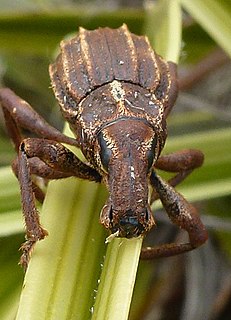
Anagotus oconnori or astelia weevil is a large flightless weevil found in New Zealand. It was first collected on Mount Quoin in Wellington from Astelia by Mr A.C. O'Connor after whom this species was named.

















